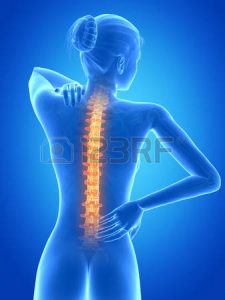Automobile Head Restraints Prevent Injuries—Use Them Correctly!
 Many people are under the mistaken impression that the head-sized extension at the top of your car’s seat is a head rest. It’s actually not a place to rest your weary head during a long drive, but rather a safety feature called a head restraint that is there to help prevent whiplash in the event of a rear-end collision. And having it adjusted properly can mean the difference between emerging unscathed and enduring weeks of neck pain, along with the cost and inconvenience of medical treatment.
Many people are under the mistaken impression that the head-sized extension at the top of your car’s seat is a head rest. It’s actually not a place to rest your weary head during a long drive, but rather a safety feature called a head restraint that is there to help prevent whiplash in the event of a rear-end collision. And having it adjusted properly can mean the difference between emerging unscathed and enduring weeks of neck pain, along with the cost and inconvenience of medical treatment.
Whiplash is the most common type of injury in an auto accident. The Insurance Bureau of Canada has conducted studies showing that the proper use of head restraints can reduce the incidence of whiplash by as much as 40%. Russ Rader of the U.S. Insurance Institute for Highway Safety (IIHS) explains what happens when you are involved in a rear end collision: “The head restraint is designed to work with your vehicle’s seat; it keeps your body and head moving together. The problem comes in if your head lags behind your body and snaps backward. That’s what leads to neck injury, or what’s commonly known as whiplash. Modern head restraints are designed to prevent whiplash, and that’s why they’re so much taller than they used to be.”
One problem is that some people find the newest head restraint designs to be uncomfortable. Some of the common complaints from users at Automedia.com include this one from the owner of a Volkswagen Jetta: “The front headrest points so forward that I get neck pain after just a few miles of driving.” Then there’s this one from a Subaru owner: “Unless you enjoy your face aiming toward your crotch, you may not be able to find a comfortable position for the headrest or your head.”
One of the reasons for the above complaints is that, in order to get good reviews from the IIHS (many people check the IIHS’s ratings for vehicles before they purchase a car) and comply with the regulations established by the Federal Government for head restraints, auto manufacturers must provide head restraints that meet specific criteria. In particular, the head restraint must be no more than 2.2 inches from the driver’s head and it must be two or more inches higher than was previously required.
A head restraint can prevent whiplash only if it is as close to your head as possible when a collision happens. When hit from behind, your head snaps quickly backward, then forward, which causes the muscles and tendons in the neck to overstretch and tear. If the head can’t snap back very far, there is much less chance of an injury occurring.
Most head restraints adjust upward and downward, and some also tilt forward and back. The best position for a head restraint is one in which the head is as close to it as possible, ensuring it is no more than two inches away. The top of the head restraint should ideally be even with the top of your head and should never be any lower than your ears.
Taking just a little time and effort to position your head restraint correctly can save you a lot of pain and suffering if you are ever in an auto accident. Your health and safety are worth it!

 We talk a lot about the importance of reaching a goal weight and how to stay motivated. Sometimes, though, it still seems like a laborious task. If you’re carrying extra weight, you probably already know there are a myriad of health-related reasons to slim down. While it may seem impossible, little steps will carry you bit by bit down your weight loss path to your ultimate goal.While keeping your eyes on the big prize, it may help you to realize that even small changes in your weight may improve blood sugar, blood pressure, heart health, reduce cholesterol, and decrease your chances of developing diabetes. We’ve shared many motivational tips, but did you know that when you lose 10% of your bodyweight, you are instantly healthier? There’s no doubt that dropping weight will make you look and feel better, but there are numerous other benefts that you can realize while on your weight loss journey, which have nothing to do with how you look in your skinny jeans. Read more: Strategies for successful maintenance after weight loss.
We talk a lot about the importance of reaching a goal weight and how to stay motivated. Sometimes, though, it still seems like a laborious task. If you’re carrying extra weight, you probably already know there are a myriad of health-related reasons to slim down. While it may seem impossible, little steps will carry you bit by bit down your weight loss path to your ultimate goal.While keeping your eyes on the big prize, it may help you to realize that even small changes in your weight may improve blood sugar, blood pressure, heart health, reduce cholesterol, and decrease your chances of developing diabetes. We’ve shared many motivational tips, but did you know that when you lose 10% of your bodyweight, you are instantly healthier? There’s no doubt that dropping weight will make you look and feel better, but there are numerous other benefts that you can realize while on your weight loss journey, which have nothing to do with how you look in your skinny jeans. Read more: Strategies for successful maintenance after weight loss. Extreme Makeover features a celebrity trainer helping very overweight individuals reach their weight loss goals. Sometimes, their attitudes aren’t great, but other times, the people on the show are truly amazing, like Sara. Sara is a little person, standing at only 4’5″. She was a nutrition speaker on local television shows at the start of her journey, but ashamed of herself. Not only had she spent her life dealing with her short stature, but she had suffered greatly at the hands of her sister. She turned to eating and by the time she was 37 years old, weighed over 200 pounds.
Extreme Makeover features a celebrity trainer helping very overweight individuals reach their weight loss goals. Sometimes, their attitudes aren’t great, but other times, the people on the show are truly amazing, like Sara. Sara is a little person, standing at only 4’5″. She was a nutrition speaker on local television shows at the start of her journey, but ashamed of herself. Not only had she spent her life dealing with her short stature, but she had suffered greatly at the hands of her sister. She turned to eating and by the time she was 37 years old, weighed over 200 pounds.


 Pre-diabetes may contribute to stroke risk but that depends largely on how prediabetes is defined, the authors of a new meta-analysis pointed out in the British Medical Journal. Since definitions of prediabetes vary, it’s difficult to determine the exact degree of risk prediabetes presents.
Pre-diabetes may contribute to stroke risk but that depends largely on how prediabetes is defined, the authors of a new meta-analysis pointed out in the British Medical Journal. Since definitions of prediabetes vary, it’s difficult to determine the exact degree of risk prediabetes presents. Imagine what happens when you injure your neck in an auto injury…
Imagine what happens when you injure your neck in an auto injury… Our sleep cycle is separated into two main components: rapid eye movement (REM) sleep and non-REM sleep (NREM). We cycle between the two all night, with four stages of NREM sleep preceding one stage of REM sleep. NREM sleep is the stage at which our body repairs itself, energy is replenished and our immune system is boosted. A complete cycle of sleep takes between 90 and 110 minutes in total, with approximately a quarter of that time being spent in REM sleep. It is also the stage during which dreaming almost always takes place. Scientists are still trying to discover the extent to which REM sleep affects our health and mental well-being, but they do know that REM sleep is important for the development of creativity and problem solving ability, and is how we learn to adapt to our world.
Our sleep cycle is separated into two main components: rapid eye movement (REM) sleep and non-REM sleep (NREM). We cycle between the two all night, with four stages of NREM sleep preceding one stage of REM sleep. NREM sleep is the stage at which our body repairs itself, energy is replenished and our immune system is boosted. A complete cycle of sleep takes between 90 and 110 minutes in total, with approximately a quarter of that time being spent in REM sleep. It is also the stage during which dreaming almost always takes place. Scientists are still trying to discover the extent to which REM sleep affects our health and mental well-being, but they do know that REM sleep is important for the development of creativity and problem solving ability, and is how we learn to adapt to our world. We’ve all heard that calcium is crucial for preventing bone and joint problems, but new research suggests there may be another mineral we need to be mindful of: zinc. In particular, a study suggests that levels of zinc within the cartilage cells may help to explain why tissue destruction occurs in patients with osteoarthritis.
We’ve all heard that calcium is crucial for preventing bone and joint problems, but new research suggests there may be another mineral we need to be mindful of: zinc. In particular, a study suggests that levels of zinc within the cartilage cells may help to explain why tissue destruction occurs in patients with osteoarthritis. We talk a lot about how to stay motivated and the importance of reaching a goal weight. Yet sometimes, it still seems like a laborious task. If you’re carrying extra weight, you probably already know there are a myriad health-related reasons to slim down. While it may seem impossible, little steps will carry you bit by bit down your weight loss path to your ultimate goal on the Doctor Supervised ChiroThin Weight Loss Program™.
We talk a lot about how to stay motivated and the importance of reaching a goal weight. Yet sometimes, it still seems like a laborious task. If you’re carrying extra weight, you probably already know there are a myriad health-related reasons to slim down. While it may seem impossible, little steps will carry you bit by bit down your weight loss path to your ultimate goal on the Doctor Supervised ChiroThin Weight Loss Program™.